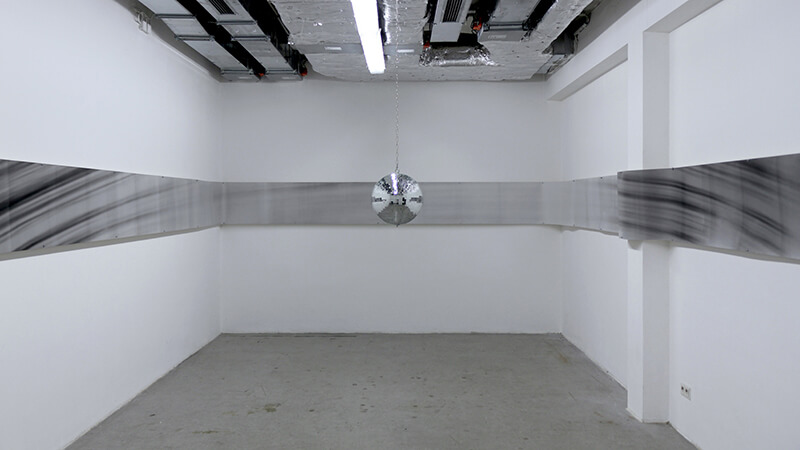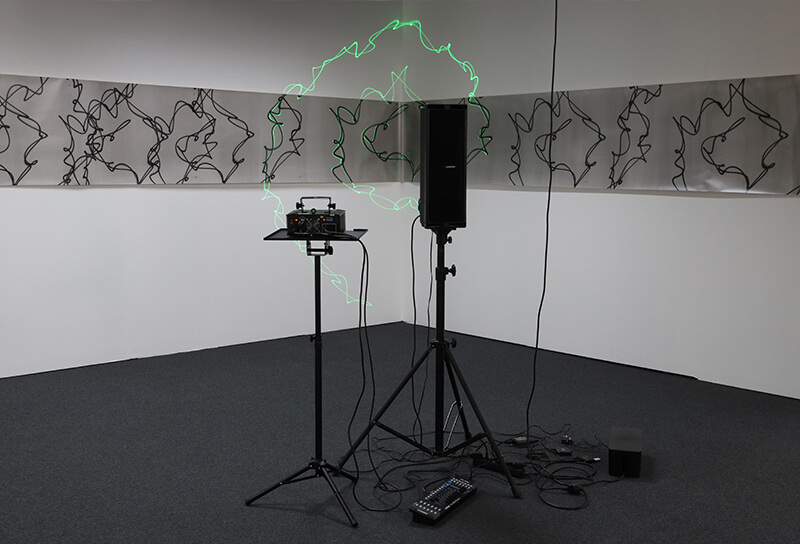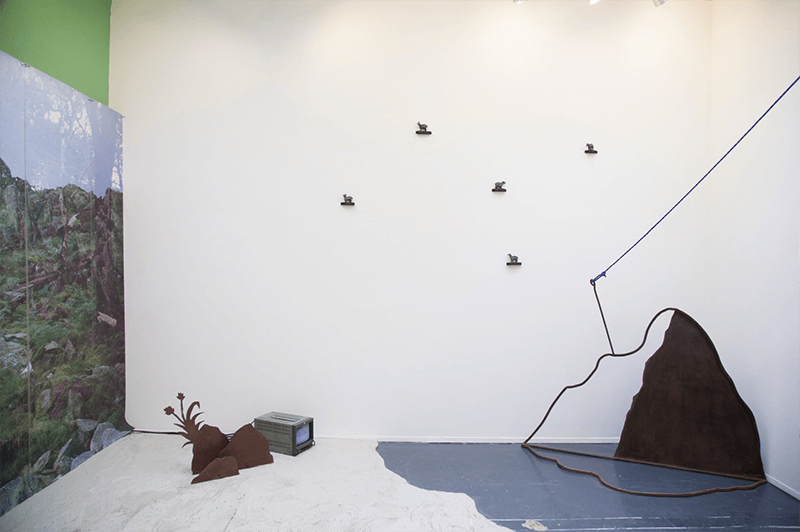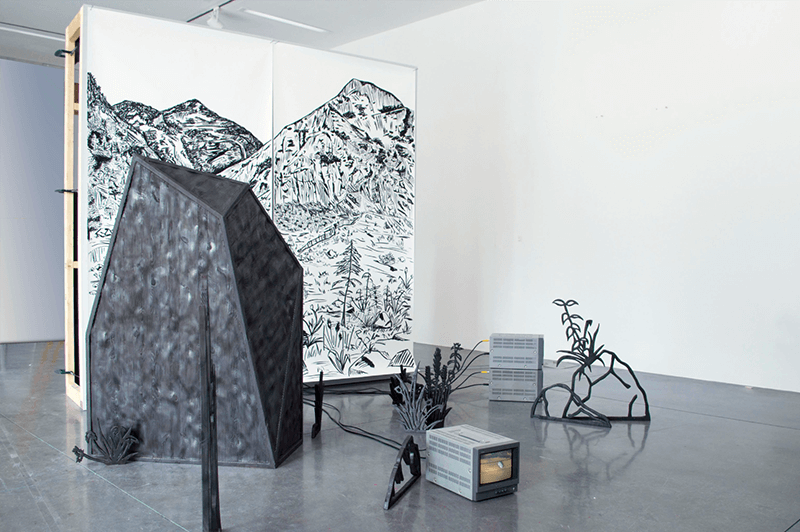Interview by Polly Bindman

From the 5th of April, the Unit 1 Gallery | Workshop is hosting an exhibition showcasing the work of 10 artists from across the globe that are taking part in the third instalment of their Radical Residency. This residency is on its third edition and provides the artists with a communal gallery space for 4 weeks in March, an initiative designed to alleviate mounting studio costs in London while encouraging dialogue between a group of interdisciplinary artists. This group includes Sam Carvosso and Tobias Becker, two artists that employ different approaches to express their fascination with the possibilities yielded by digital technologies and how they shape the way we see the world.
Sam Carvosso is a visual artist whose work primarily focuses on landscapes and the natural world, often mediated through technology; specifically, he explores the notion of creating a pseudo-reality within landscapes and the combined effects of memory, nostalgia and the media. He is interested in the ways that places can be perceived through social media platforms, Google images and memories and how they can collectively create a new, or pseudo, space.
His past installations include Hiking Trails (2017) and Forest Clearing (2017), which appear like interior sculptural assemblages of exterior environments. These pieces perform a kind of visual synecdoche, and by inviting the viewer to navigate a kind of trail within the confines of the gallery space, ask us to question the distinction between interior and exterior spaces and how we move within them. Recently, Carvosso’s interest in the West American landscape took him to the Yellowstone National Park in Wyoming, where he spent a month camping, with the aim of comparing his own experiences of the place with its depiction in films and novels.
Through conversations with park rangers, writers, and hikers, he began to ponder topics ranging from the creation of ‘wilderness’ and the role of animals as a ‘reality check’ – subjects that have informed the core of his current practice. His experiences of a campsite being his studio space have led him to consider the confusing boundary between ‘backcountry’ and ‘frontcountry, bringing a new awareness of his surroundings to his forthcoming work.
Tobias Becker is an artist who uses installation, film and photograms in his work, mixing elements of today’s digital reality with rudimentary analogue systems to explore the collision of past, present and future. Becker’s fascination with digital technology began while at art school in Germany, where he studied Time Based Media. His conceptual influences include media philosopher Villem Flusser, who posits the notion that in technology we see culture since these items are an extension of ourselves.
Building upon this notion that how we see the world is predefined by the technology we use, Becker explores the ways that an analogue past can bear something new or different in our present day, and add value to the already familiar digital. Using analogue photography and film, Becker shows miniatures or fragments of our reality, visualized and conserved through chemical processes on a light-sensitive material.
In the cobra effect (2018), he uses light-sensitive paper held on a smartphone screen in the moment of scrolling through an Instagram profile and repeated with several Instagram accounts to create a projected image that summarizes all the photos on one account. This amounts to a projection in which no single image can be detected anymore, only fragments of the profile images. By distilling a moment of vacuous scrolling into one single image, freezing continuous digital activity within an analogue time frame, Becker asks us to consider the way we process information in the digital age.
Becker sees his works as spaces of memory and uncertainty that can be read as a reassuring myth despite the instability of the reality they depict. His finished works are meeting places where different timelines collide but also go hand in hand to form something new – experiments that show situations of an impossible coexistence between past and present. The intention is to make visible what we often overlook: The connection of bygone time and progressive movement, exploring how moments build upon each other and how fast the world turns.
Radical Residency III is at Unit 1 Gallery | Workshop, London, working studio dates: 4-31 March, exhibition dates: 5-25 April



Right: As Real as It Gets, Sam Carvosso (2017)
You are taking part in the Radical Residency programme, which brings artists from across the world into a shared studio space for 4 weeks. Could you tell us more details about the project you are developing during the one-month residency and how you came up with the project?
Sam Carvosso: I’ll be developing a project surrounding the current research of my time spent in Yellowstone National Park. Within the park, there is a somewhat undefined line between the back and front country. Frontcountry has roads, and backcountry has trails, but these two cross over quite a bit too. Frontcountry can sometimes feel a bit theatrical, with everyone in cars watching the animals or sitting in front of Old Faithful Geyser, ready for the predicted eruption. Backcountry is more gritty. I daresay more “real” – as both of these things are – but it feels closer to our expected version of reality produced via Google images, films, etc. I’m hoping to make work that tackles this elusive line between reality and fantasy.
Tobias Becker: My artistic approach is similar to the one of an ethnographer in sociology. I am looking for what I call “rudiments of time“: things, places, events, and people who represent a collision of past and present. When I find something, I am becoming a kind of participant observer. Whilst I am taking part, talking, and trying out, I am also analysing these rudiments from a distance and checking what interests me. I don’t remember how we got onto the topic, but I was talking with a friend about the train system in London when I first arrived here two weeks ago. She told me about parliamentary trains, so-called “ghost trains”, which is a train service that runs very occasionally in order to keep a track open. Without such a ghost train, the train company would be forced to close the track, which is a costly process.
But by running a once-a-day train, the track is technically still in use, avoiding the need of shutting it down. I decided to ride one such ghost train near London. A couple of days later, I went to Blackpool Pleasure Beach and found out about the ‘Ghost Train’ ride in the theme park, which was the first of its kind in the world. I decided to compare the experience of riding on these two trains: one is an abandoned train which no one rides or needs anymore; the other one in the amusement park is about the presence of something supernatural. The resulting work will be a film and two multi-exposures of the train rides, inspired by the aesthetics of the first faked ghost photographs from the 1860s.
There’s also another project which has been on my mind since I started working at the gallery as a resident. Unit 1 Gallery | Workshop is located near the site of Grenfell Tower, a 24-storey block of flats where a devastating fire in 2017 caused 72 deaths. I once read an article about historic recurrence, the belief that certain events repeat in history in a similar kind of way. Grenfell made me think of the Great Fire of London in 1666. Researching more about these two events, I was surprised to find similarities. I just started working on this project, so we will see what the outcome is.
How does this residency shape the way you approach your artistic practice?
Sam Carvosso: I haven’t shared gallery space with as many people like this since studying at the Royal College of Art a couple of years ago. This will definitely affect the way I approach my practice, and I’m sure it will continue to develop through conversations with all the residents and visitors. The gallery space is also incredible, with large windows and tall ceilings, allowing me to be ambitious with scale. My work can often be deconstructed and reconstructed multiple times as a way of thinking through making, which is definitely useful when the work is already situated within the gallery space.
Tobias Becker: Unit 1 Gallery | Workshop, which houses many possibilities for emerging artists, curators and writers, for me, is a space of support. Coming from Germany and not knowing the area is a real obstacle since I am working with my surroundings. The people at the gallery are very supportive and helped me with knowledge, material and discussion. The Radical Residency is so interesting because I am sharing the space with 9 other artists in one big open room.
There are a lot of influences you can work with. The gallery, for me, became a place of thinking and reflection. Working predominantly outside, taking photos, and filming means processing a lot of impressions. Unit 1 Gallery | Workshop is the place where I can do that – thinking, researching and talking about what I am working on. There’s always someone I can chat with, and this culture of exchange and support is what makes it so great.
What directions do you see taking your work into?
Sam Carvosso: My work is currently attempting to create and describe elements of a place. This often means I have to go through a research period within a new context – I’m currently looking at National Parks in North America. I’m planning a trip to Yosemite National Park this year, and I’m interested in how this differs from the other parks I have been too, especially how the area has been affected following the devastating wildfires that hit the region last year.
Tobias Becker: Coming from a more sculptural, technical and formal approach, I am now more and more interested in rudiments of time in social terms and events. After analysing technology itself, I am now using technological peculiarities symbolically to describe our society.
How do you cope with creative desperation?
Sam Carvosso: I usually play around with things in my studio until something interesting happens, but I also have a list in my studio of ten things to consider when feeling a bit stuck. I also make a lot of animal models, which I find quite meditative as it allows me time to think.
Tobias Becker: When creating a work, I usually already know how the end result should look – often, I imagine how the final installation will be before I even started a project. Within the process, there are no real problems, only some screws to adjust. Creative desperation usually comes into play when finishing a project and being in the process of cutting the cord to the last work and moving on. During this period, I like reading a lot of theoretical stuff all about photography, cinematographic objects and film.
You couldn’t live without…
Sam Carvosso: Probably my Leatherman multi-tool. I use it almost every day!
Tobias Becker: Star Trek.






